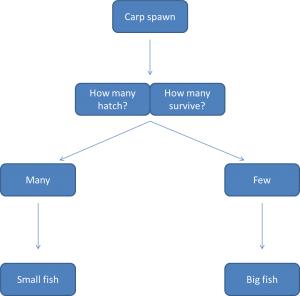In the parts of the world where carp are less than popular with the general public, it can be very hard to tell if a body of water will hold large carp before actually fishing in it and finding out (and possibly wasting your time). The factors that allow a lake or river to contain large carp are many and difficult to pin down. However, there are some things that do seem to contribute to how big the carp can get. These factors are similar to those of any other “sport” fish species, and while not often applied to carp in the USA I think they will at least help to narrow down the choices of what waters are worth a try.
The theory behind this is pretty clear when you think about the life history of carp. The more carp there are, the more competition there is for food. This leads to there being less food for each individual carp, which leads to slower growth and smaller average size.
So we will focus on factors that contribute to too many carp in the water:
Spawning areas
While at first it might seem that an ample spawning area would be good for a carp fishery this is not always the case. Obviously the general trend is the more suitable spawning habitat (shallow weedy areas) the more carp there will be. So, look for waters that have a limited amount of shallow, weedy areas.

Bottom and water clarity
When the bottom is soft (think muddy), large numbers of feeding carp can stir up the bottom, uproot vegetation, and cause the water to become muddier. This muddy water is good for protection from predators, which most often feed by sight (like bass or pike). However, this also causes a loss of aquatic vegetation as the sunlight they need to grow can no longer reach the bottom. This vegetation dies and makes the bottom easier to stir up, making the water even muddier. This is bad because many of the carps’ food items are found in vegetated areas. The net effect is smaller, stunted carp. Carp causing muddy water only really occurs when there is a lot of carp in the water – if you think the whole body of water is muddy due to carp feeding, you might want to look elsewhere.

Food
Big carp require lots of food. In European waters this is often not a problem as many of the carp are feeding on food items introduced by anglers. In waters where the carp are not fed by humans, the food they select can vary greatly with the location. The bulk of a carp’s diet is made up of bloodworms, which there are often a lot of and are available pretty much all year. They would prefer larger food items, such as snails, mussels, and crayfish, but these items have to be easy enough to crack open. Studies have shown that when carp are given a choice between hard and soft-shelled snails, they will go for the soft ones first. So when you get to a new lake, take a small net and scoop along the bottom. If you find small invertebrates you can crush with your fingers, you’ve found some good carp food!

Predators
Carp are a very prolific and hardy species that can quickly populate a body of water. If left unchecked carp will consume all the resources available and will become stunted and in poor condition. A necessary component of good carp waters is a decent predator population that will keep the carp from becoming too numerous. Any species that eats fish will eat a small carp. However, it takes a larger predator to eat a carp that has gotten bigger than about 4-6 inches. A good population of large predators such as flathead or blue catfish is often a good sign that there will be some good carp as well.
Carp removal projects In fisheries terms, a good sport fishery is one that has a high biomass and low density (that is, fewer, but larger fish). Carp removal projects only work if every carp is killed, which means you have to remove all the fish either by rotenone (poison) or draining. Efforts that remove the better fish (think bowfishing) or most but not all the carp (think netting) just make things worse as it triggers a spawn of the smaller carp that remain. This results in – guess what carp haters – a lot more really small carp! This makes no one happy. It is much better to remove the smaller individuals and leave the larger ones in the lake.In summary
The bottom line is very simple. The more carp that survive from each spawning lowers the amount of food per carp, thus making the carp attain a smaller size. Lakes with the biggest carp will have fewer spawning areas, hard bottoms, clear water, and lots of food and predators. Of course things are not always this simple, but this general scheme should help to narrow down your search as you look to fish new waters.



